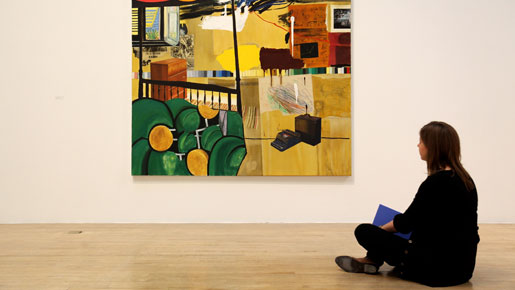
When the shortlist of four exhibitors for the £25,000 [€27,750] prize was announced in October, the 25th year of “The Turner”, the general reaction was true to form. Both art critics and the tabloids had the usual trouble trying to deal with the nominations.
This year, the artists’ inspirational raw material included ground dust from the engine of a passenger jet, the brain of a cow, the skull of a sperm whale, gold paint on a wall, and a set of stuffed figures on a stage including a bare-bottomed builder.
Also true to form, the critics diverged widely in their interpretations of what the works actually mean. Roger Hiorn, the “alchemist interventionist” working with engine dust and freeze-dried bovine brain matter, is said to be prodding viewers to consider the “dematerialisation” of things. It could be about our relationship with technology, suggests Helen Little, curator of the Tate Britain gallery, venue for the exhibition.
As for Lucy Skaer’s giant skull, which can only be glimpsed behind screens, most critics are baffled. Adrian Searle of The Guardian, appears to wonder whether the exhibit, called Leviathan Edge 2009, has something to do with the food chain? “This is the last thing a squid would see before being scooped into the creature’s maw,” he muses. “Is it relevant that Moby Dick was also a sperm whale? I want to like this more than I do, but it is all a bit unfathomable.”
The intentions of Richard Wright, the artist who has painstakingly applied paint to a wall in the medieval manner, remain similarly elusive. “From a distance, this is hard to decipher; it is just as hard closer up,” confesses Searle. However Tate curators enthuse over the warm glow thrown by the large exhibit. When the winner is announced on December 7, win or lose, Wright will paint over the work.
Finally, Italy’s “contemporary surrealist” Enrico David has arranged dolls and figures on a stage including the bare-bottomed builder in an exhibit called Absuction Cardigan. “All this is enjoyable, and I don’t worry too much about what the narrative is, because I can happily make one up for myself,” concludes one critic. Although it’s pure coincidence, Tate curator Little suggests all the exhibits share the common characteristic of “transformation”, the essential perishability of things.
Meantime the organisers have never felt any obligation to apologise for the controversy the prize generally arouses. Indeed controversy is part of the fun and they generally end up defending themselves if the award fails to generate the usual mix of praise and scorn, such is its history.
Just last year, for instance, there wasn’t a single painter on the shortlist, an omission which many considered scandalous considering that the prize is named after landscape artist JMW Turner whose work foreshadowed the French Impressionists. The winner turned out to be Mark Leckey with a video of himself talking to cartoon characters Felix the Cat and Homer Simpson. However many were relieved that the winning exhibit wasn’t the video showing crockery being smashed in slow motion, a far cry from Turner’s dreamy landscapes. Meantime the founders of the award say it was named for Turner only because he wanted to establish a prize for young artists but never did, as well as because he’s universally regarded as one of the great British artists. So far however, not quite half the winners have been painters or sculptors.
There’s hardly a year goes by that the judges aren’t accused of elitism, myopia or worse. Probably the most controversial nomination remains Tracy Emin in 1999 for My Bed, an untidy jumble of sheets and other night-time detritus. As the prize’s own account of that particular cause celebre notes: “[The exhibit] completely hi-jacked the exhibition, sparking violent critical response and dividing opinion along the lines of accessibility versus elitism.” Then secretary of state for culture, Chris Smith, was moved to complain that some young British artists were giving the country a bad name abroad. Three years later, another government minister, Kim Howells, described the exhibits as “cold, mechanical bullshit”.
Along the way, even the most avant-garde sections of the contemporary art scene have had serious difficulty with certain exhibits, like the one featuring lights switching on and off, or another of a fully-functioning office. As in most things associated with contemporary art, all attempts to take the heat out of the award have failed miserably. For instance, when the shortlist was briefly dropped in the eighties, the outcry following its abandonment was greater than when it was included. “The Turner’s a huge debating moment,” summarises art critic (and 2009 judge) Jonathan Jones. “People do become empowered about contemporary art.”
So as the Turner Prize celebrates its 25th, controversial year, Stephen Deuchar, director of Tate Britain, insists the competition is in rude health. “Say what you like about [it]” he says, “it does provide a great arena when new talent is put before the public.” And you can bet the announcement of the winner on December 7, 2009 during a live Channel 4 broadcast will be met with the usual heapings of praise and howls of disapproval.

